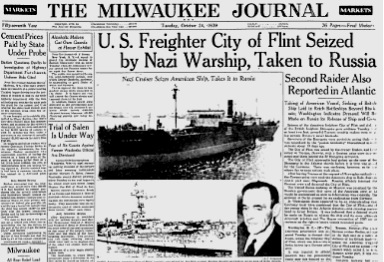The United States didn’t join the war until attacked by Japan in 1941. After Pearl Harbor, Germany quickly declared war on the United States. Even though public opinion ovrwhelmingly favored a declaration of war against both Germany and Japan after Pearl Harbor, President Roosevelt didn’t ask Congress for war against Germany. A few days later, Germany obliged by declaring war.
But there was little doubt that the U.S. would be at war with Germany. The Germans had been menacing American shipping, and there soon would have been cause for war with Germany. The first incident in this de facto war took place 75 years ago, as reported here in the October 24, 1939, edition of the Milwaukee Journal.
The SS City of Flint became the first U.S. vessel to be seized by the Germans. It was en route to Britain with a cargo of tractors, grain, and fruit. The Germans declared the cargo to be contraband and seized the vessel. The German crew set sail for neutral Norway, but was refused entry. It then sailed for the Soviet Union, then a German ally, which eventually sent it away. The ship eventually wound up in Norway a second time, where it was eventually boarded by the Norwegians and returned to the Americans. The ship unloaded its cargo in Norway and returned to the U.S. The ship remained in service until 1943, when it was sunk by a German U-boat.


My father, Wm. C. Bohn, was the radio operator on the City of Flint when she was torpedoed. The water was covered in burning gasoline, so he tied a rope around his emergency radio and threw it over. The splash parted the flames, and he dove in and swam to a lifeboat with the rope in his teeth. His signals were picked up and the men were rescued by a Portugese destroyer. However, steaming for the Azores, the destroyer was struck by a rogue wave. It listed over by 92 degrees and righted itself–setting a maritime record for a steam propelled vessel, unfortunately with the loss of one Portugese sailor. The were let of on the Azores where they got other ships or paid to take the Pan Am clipper back to the U.S.